Formation of Market Entry Strategy with Decision-Making: A Case Study
VerifiedAdded on 2022/10/19
|72
|26663
|19
Thesis and Dissertation
AI Summary
This bachelor thesis investigates the formation of market entry strategies within a multinational company, specifically in a B2B context, with a focus on the decision-making process. The research employs a qualitative approach using a case study methodology, gathering empirical data through in-depth interviews. The study explores the complexities of international market selection, entry mode choices, and product portfolio decisions, highlighting how these are influenced by internal and external environmental factors. The findings challenge the notion of a linear, sequential strategy, instead portraying strategy as an emergent process shaped by ongoing decisions. The thesis also examines factors affecting market entry, teamwork dynamics, and cultural differences, offering insights into the strategic decision-making of businesses in a globalized world. The research concludes that market entry strategy is subject to adjustments based on internal and external environments.
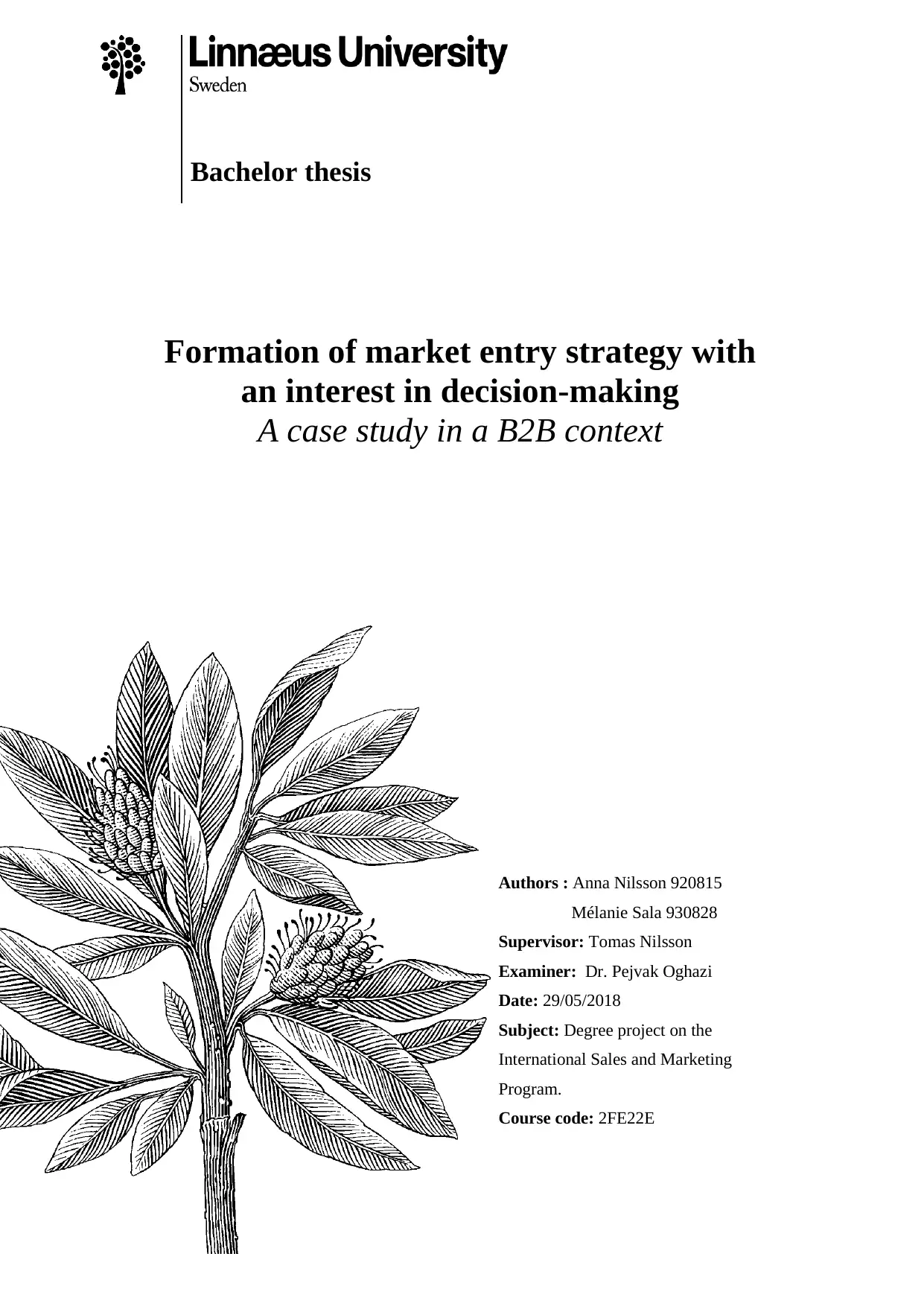
Bachelor thesis
Authors : Anna Nilsson 920815
Mélanie Sala 930828
Supervisor: Tomas Nilsson
Examiner: Dr. Pejvak Oghazi
Date: 29/05/2018
Subject: Degree project on the
International Sales and Marketing
Program.
Course code: 2FE22E
Formation of market entry strategy with
an interest in decision-making
A case study in a B2B context
Authors : Anna Nilsson 920815
Mélanie Sala 930828
Supervisor: Tomas Nilsson
Examiner: Dr. Pejvak Oghazi
Date: 29/05/2018
Subject: Degree project on the
International Sales and Marketing
Program.
Course code: 2FE22E
Formation of market entry strategy with
an interest in decision-making
A case study in a B2B context
Paraphrase This Document
Need a fresh take? Get an instant paraphrase of this document with our AI Paraphraser
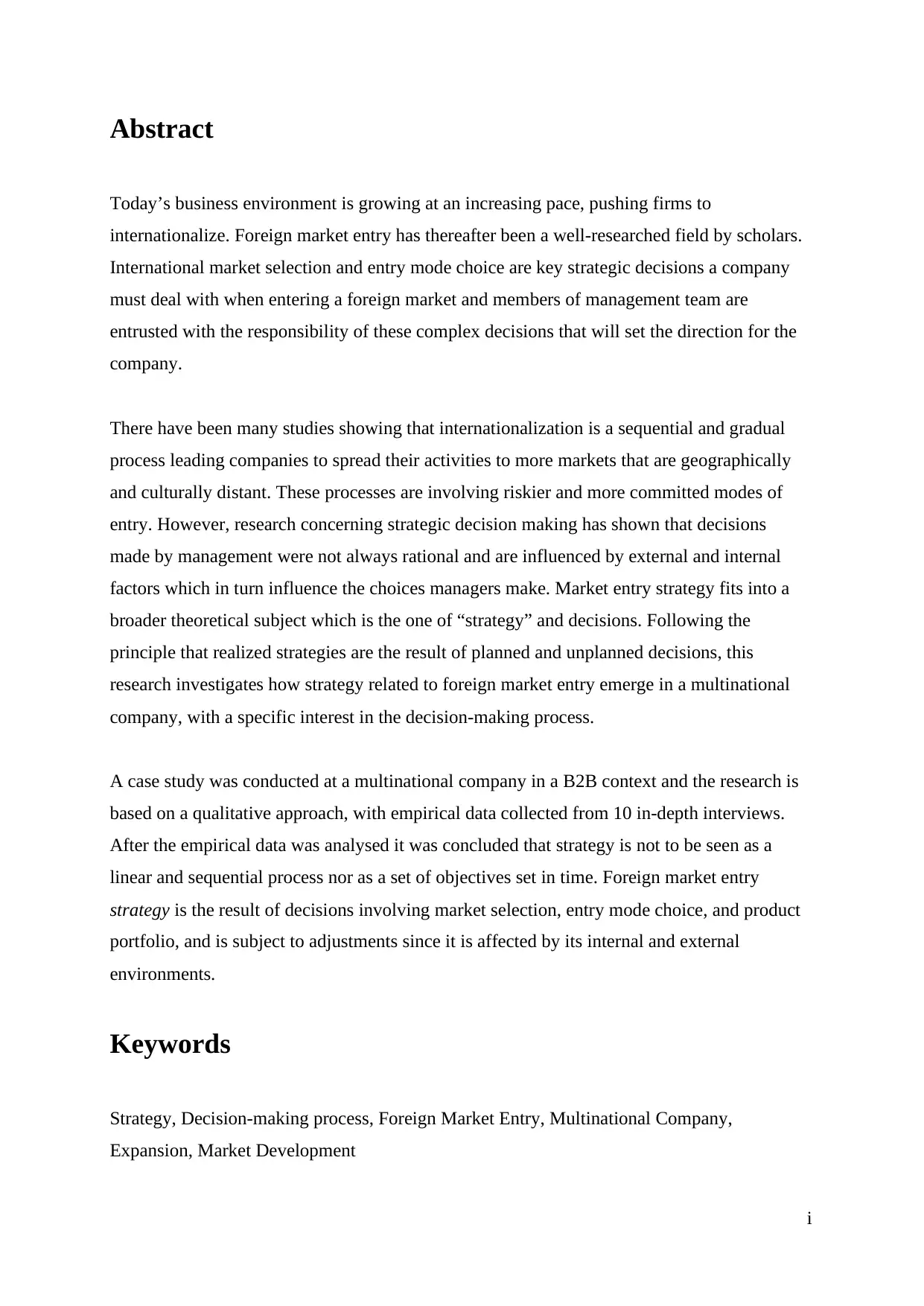
i
Abstract
Today’s business environment is growing at an increasing pace, pushing firms to
internationalize. Foreign market entry has thereafter been a well-researched field by scholars.
International market selection and entry mode choice are key strategic decisions a company
must deal with when entering a foreign market and members of management team are
entrusted with the responsibility of these complex decisions that will set the direction for the
company.
There have been many studies showing that internationalization is a sequential and gradual
process leading companies to spread their activities to more markets that are geographically
and culturally distant. These processes are involving riskier and more committed modes of
entry. However, research concerning strategic decision making has shown that decisions
made by management were not always rational and are influenced by external and internal
factors which in turn influence the choices managers make. Market entry strategy fits into a
broader theoretical subject which is the one of “strategy” and decisions. Following the
principle that realized strategies are the result of planned and unplanned decisions, this
research investigates how strategy related to foreign market entry emerge in a multinational
company, with a specific interest in the decision-making process.
A case study was conducted at a multinational company in a B2B context and the research is
based on a qualitative approach, with empirical data collected from 10 in-depth interviews.
After the empirical data was analysed it was concluded that strategy is not to be seen as a
linear and sequential process nor as a set of objectives set in time. Foreign market entry
strategy is the result of decisions involving market selection, entry mode choice, and product
portfolio, and is subject to adjustments since it is affected by its internal and external
environments.
Keywords
Strategy, Decision-making process, Foreign Market Entry, Multinational Company,
Expansion, Market Development
Abstract
Today’s business environment is growing at an increasing pace, pushing firms to
internationalize. Foreign market entry has thereafter been a well-researched field by scholars.
International market selection and entry mode choice are key strategic decisions a company
must deal with when entering a foreign market and members of management team are
entrusted with the responsibility of these complex decisions that will set the direction for the
company.
There have been many studies showing that internationalization is a sequential and gradual
process leading companies to spread their activities to more markets that are geographically
and culturally distant. These processes are involving riskier and more committed modes of
entry. However, research concerning strategic decision making has shown that decisions
made by management were not always rational and are influenced by external and internal
factors which in turn influence the choices managers make. Market entry strategy fits into a
broader theoretical subject which is the one of “strategy” and decisions. Following the
principle that realized strategies are the result of planned and unplanned decisions, this
research investigates how strategy related to foreign market entry emerge in a multinational
company, with a specific interest in the decision-making process.
A case study was conducted at a multinational company in a B2B context and the research is
based on a qualitative approach, with empirical data collected from 10 in-depth interviews.
After the empirical data was analysed it was concluded that strategy is not to be seen as a
linear and sequential process nor as a set of objectives set in time. Foreign market entry
strategy is the result of decisions involving market selection, entry mode choice, and product
portfolio, and is subject to adjustments since it is affected by its internal and external
environments.
Keywords
Strategy, Decision-making process, Foreign Market Entry, Multinational Company,
Expansion, Market Development
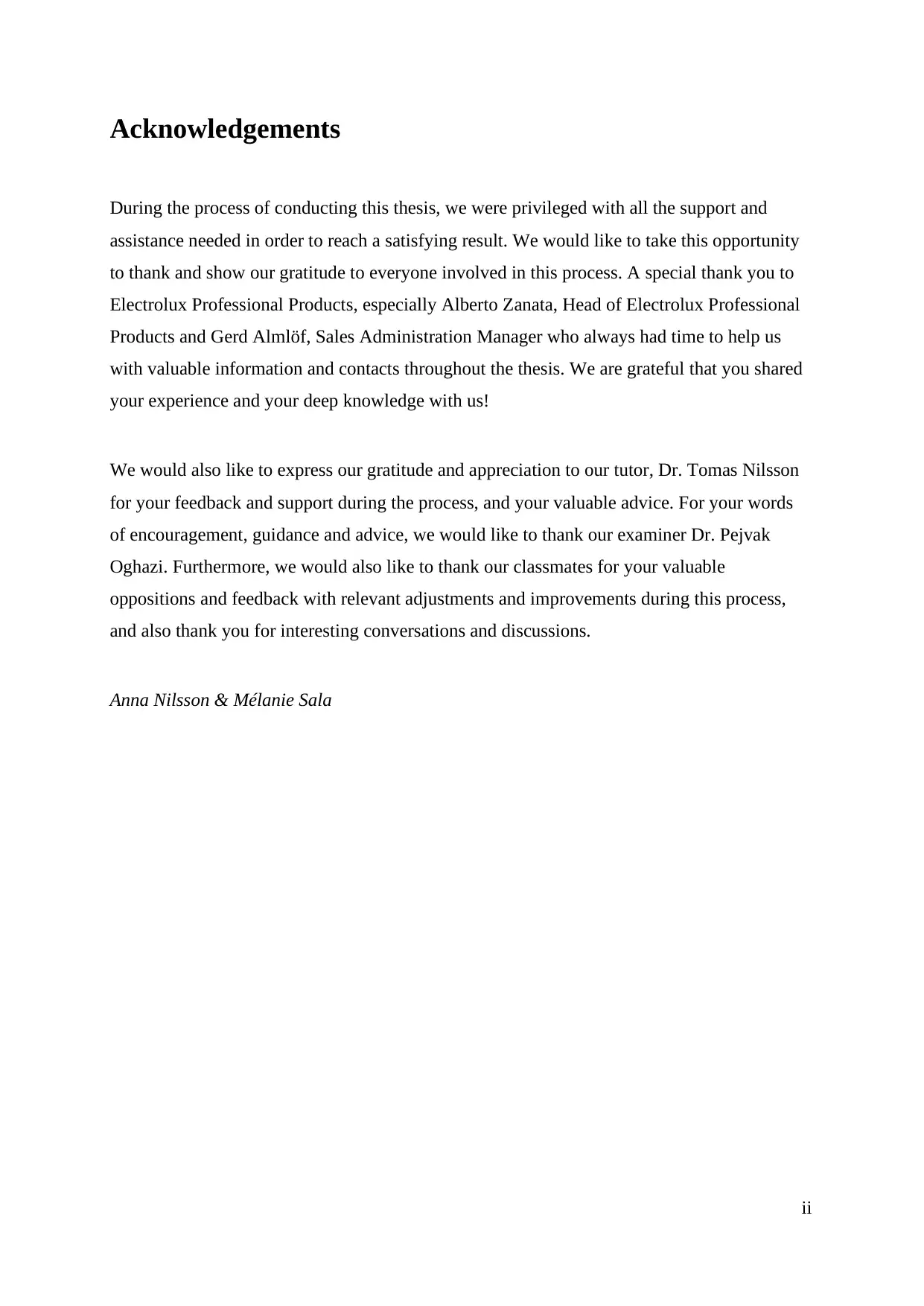
ii
Acknowledgements
During the process of conducting this thesis, we were privileged with all the support and
assistance needed in order to reach a satisfying result. We would like to take this opportunity
to thank and show our gratitude to everyone involved in this process. A special thank you to
Electrolux Professional Products, especially Alberto Zanata, Head of Electrolux Professional
Products and Gerd Almlöf, Sales Administration Manager who always had time to help us
with valuable information and contacts throughout the thesis. We are grateful that you shared
your experience and your deep knowledge with us!
We would also like to express our gratitude and appreciation to our tutor, Dr. Tomas Nilsson
for your feedback and support during the process, and your valuable advice. For your words
of encouragement, guidance and advice, we would like to thank our examiner Dr. Pejvak
Oghazi. Furthermore, we would also like to thank our classmates for your valuable
oppositions and feedback with relevant adjustments and improvements during this process,
and also thank you for interesting conversations and discussions.
Anna Nilsson & Mélanie Sala
Acknowledgements
During the process of conducting this thesis, we were privileged with all the support and
assistance needed in order to reach a satisfying result. We would like to take this opportunity
to thank and show our gratitude to everyone involved in this process. A special thank you to
Electrolux Professional Products, especially Alberto Zanata, Head of Electrolux Professional
Products and Gerd Almlöf, Sales Administration Manager who always had time to help us
with valuable information and contacts throughout the thesis. We are grateful that you shared
your experience and your deep knowledge with us!
We would also like to express our gratitude and appreciation to our tutor, Dr. Tomas Nilsson
for your feedback and support during the process, and your valuable advice. For your words
of encouragement, guidance and advice, we would like to thank our examiner Dr. Pejvak
Oghazi. Furthermore, we would also like to thank our classmates for your valuable
oppositions and feedback with relevant adjustments and improvements during this process,
and also thank you for interesting conversations and discussions.
Anna Nilsson & Mélanie Sala
⊘ This is a preview!⊘
Do you want full access?
Subscribe today to unlock all pages.

Trusted by 1+ million students worldwide
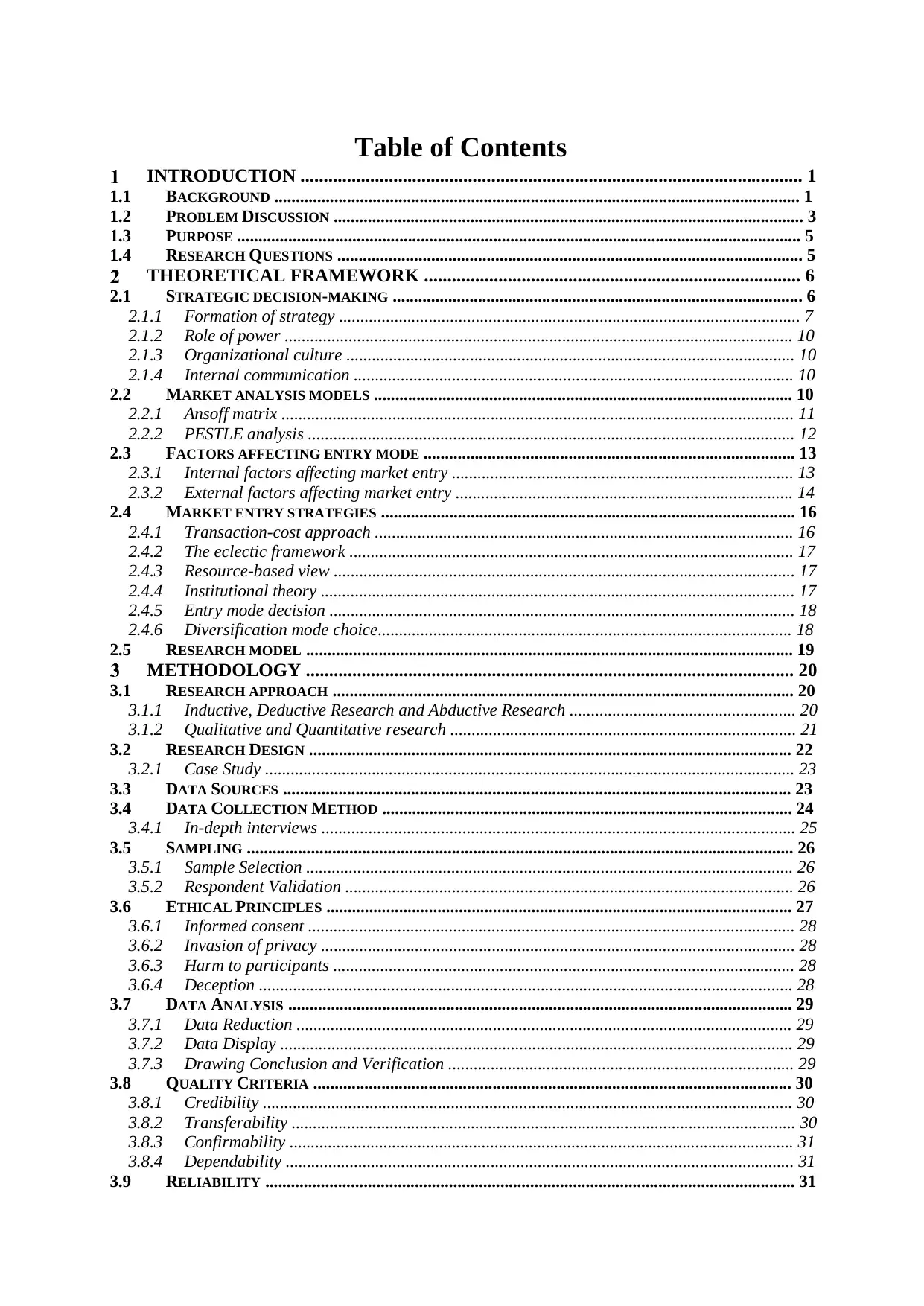
Table of Contents
INTRODUCTION ............................................................................................................ 1
1.1 BACKGROUND ........................................................................................................................... 1
1.2 PROBLEM DISCUSSION .............................................................................................................. 3
1.3 PURPOSE .................................................................................................................................... 5
1.4 RESEARCH QUESTIONS ............................................................................................................. 5
THEORETICAL FRAMEWORK ................................................................................. 6
2.1 STRATEGIC DECISION-MAKING ................................................................................................ 6
2.1.1 Formation of strategy ............................................................................................................ 7
2.1.2 Role of power ....................................................................................................................... 10
2.1.3 Organizational culture ......................................................................................................... 10
2.1.4 Internal communication ....................................................................................................... 10
2.2 MARKET ANALYSIS MODELS .................................................................................................. 10
2.2.1 Ansoff matrix ........................................................................................................................ 11
2.2.2 PESTLE analysis .................................................................................................................. 12
2.3 FACTORS AFFECTING ENTRY MODE ....................................................................................... 13
2.3.1 Internal factors affecting market entry ................................................................................ 13
2.3.2 External factors affecting market entry ............................................................................... 14
2.4 MARKET ENTRY STRATEGIES ................................................................................................. 16
2.4.1 Transaction-cost approach .................................................................................................. 16
2.4.2 The eclectic framework ........................................................................................................ 17
2.4.3 Resource-based view ............................................................................................................ 17
2.4.4 Institutional theory ............................................................................................................... 17
2.4.5 Entry mode decision ............................................................................................................. 18
2.4.6 Diversification mode choice................................................................................................. 18
2.5 RESEARCH MODEL .................................................................................................................. 19
METHODOLOGY ......................................................................................................... 20
3.1 RESEARCH APPROACH ............................................................................................................ 20
3.1.1 Inductive, Deductive Research and Abductive Research ..................................................... 20
3.1.2 Qualitative and Quantitative research ................................................................................. 21
3.2 RESEARCH DESIGN ................................................................................................................. 22
3.2.1 Case Study ............................................................................................................................ 23
3.3 DATA SOURCES ....................................................................................................................... 23
3.4 DATA COLLECTION METHOD ................................................................................................ 24
3.4.1 In-depth interviews ............................................................................................................... 25
3.5 SAMPLING ................................................................................................................................ 26
3.5.1 Sample Selection .................................................................................................................. 26
3.5.2 Respondent Validation ......................................................................................................... 26
3.6 ETHICAL PRINCIPLES ............................................................................................................. 27
3.6.1 Informed consent .................................................................................................................. 28
3.6.2 Invasion of privacy ............................................................................................................... 28
3.6.3 Harm to participants ............................................................................................................ 28
3.6.4 Deception ............................................................................................................................. 28
3.7 DATA ANALYSIS ...................................................................................................................... 29
3.7.1 Data Reduction .................................................................................................................... 29
3.7.2 Data Display ........................................................................................................................ 29
3.7.3 Drawing Conclusion and Verification ................................................................................. 29
3.8 QUALITY CRITERIA ................................................................................................................ 30
3.8.1 Credibility ............................................................................................................................ 30
3.8.2 Transferability ...................................................................................................................... 30
3.8.3 Confirmability ...................................................................................................................... 31
3.8.4 Dependability ....................................................................................................................... 31
3.9 RELIABILITY ............................................................................................................................ 31
INTRODUCTION ............................................................................................................ 1
1.1 BACKGROUND ........................................................................................................................... 1
1.2 PROBLEM DISCUSSION .............................................................................................................. 3
1.3 PURPOSE .................................................................................................................................... 5
1.4 RESEARCH QUESTIONS ............................................................................................................. 5
THEORETICAL FRAMEWORK ................................................................................. 6
2.1 STRATEGIC DECISION-MAKING ................................................................................................ 6
2.1.1 Formation of strategy ............................................................................................................ 7
2.1.2 Role of power ....................................................................................................................... 10
2.1.3 Organizational culture ......................................................................................................... 10
2.1.4 Internal communication ....................................................................................................... 10
2.2 MARKET ANALYSIS MODELS .................................................................................................. 10
2.2.1 Ansoff matrix ........................................................................................................................ 11
2.2.2 PESTLE analysis .................................................................................................................. 12
2.3 FACTORS AFFECTING ENTRY MODE ....................................................................................... 13
2.3.1 Internal factors affecting market entry ................................................................................ 13
2.3.2 External factors affecting market entry ............................................................................... 14
2.4 MARKET ENTRY STRATEGIES ................................................................................................. 16
2.4.1 Transaction-cost approach .................................................................................................. 16
2.4.2 The eclectic framework ........................................................................................................ 17
2.4.3 Resource-based view ............................................................................................................ 17
2.4.4 Institutional theory ............................................................................................................... 17
2.4.5 Entry mode decision ............................................................................................................. 18
2.4.6 Diversification mode choice................................................................................................. 18
2.5 RESEARCH MODEL .................................................................................................................. 19
METHODOLOGY ......................................................................................................... 20
3.1 RESEARCH APPROACH ............................................................................................................ 20
3.1.1 Inductive, Deductive Research and Abductive Research ..................................................... 20
3.1.2 Qualitative and Quantitative research ................................................................................. 21
3.2 RESEARCH DESIGN ................................................................................................................. 22
3.2.1 Case Study ............................................................................................................................ 23
3.3 DATA SOURCES ....................................................................................................................... 23
3.4 DATA COLLECTION METHOD ................................................................................................ 24
3.4.1 In-depth interviews ............................................................................................................... 25
3.5 SAMPLING ................................................................................................................................ 26
3.5.1 Sample Selection .................................................................................................................. 26
3.5.2 Respondent Validation ......................................................................................................... 26
3.6 ETHICAL PRINCIPLES ............................................................................................................. 27
3.6.1 Informed consent .................................................................................................................. 28
3.6.2 Invasion of privacy ............................................................................................................... 28
3.6.3 Harm to participants ............................................................................................................ 28
3.6.4 Deception ............................................................................................................................. 28
3.7 DATA ANALYSIS ...................................................................................................................... 29
3.7.1 Data Reduction .................................................................................................................... 29
3.7.2 Data Display ........................................................................................................................ 29
3.7.3 Drawing Conclusion and Verification ................................................................................. 29
3.8 QUALITY CRITERIA ................................................................................................................ 30
3.8.1 Credibility ............................................................................................................................ 30
3.8.2 Transferability ...................................................................................................................... 30
3.8.3 Confirmability ...................................................................................................................... 31
3.8.4 Dependability ....................................................................................................................... 31
3.9 RELIABILITY ............................................................................................................................ 31
Paraphrase This Document
Need a fresh take? Get an instant paraphrase of this document with our AI Paraphraser
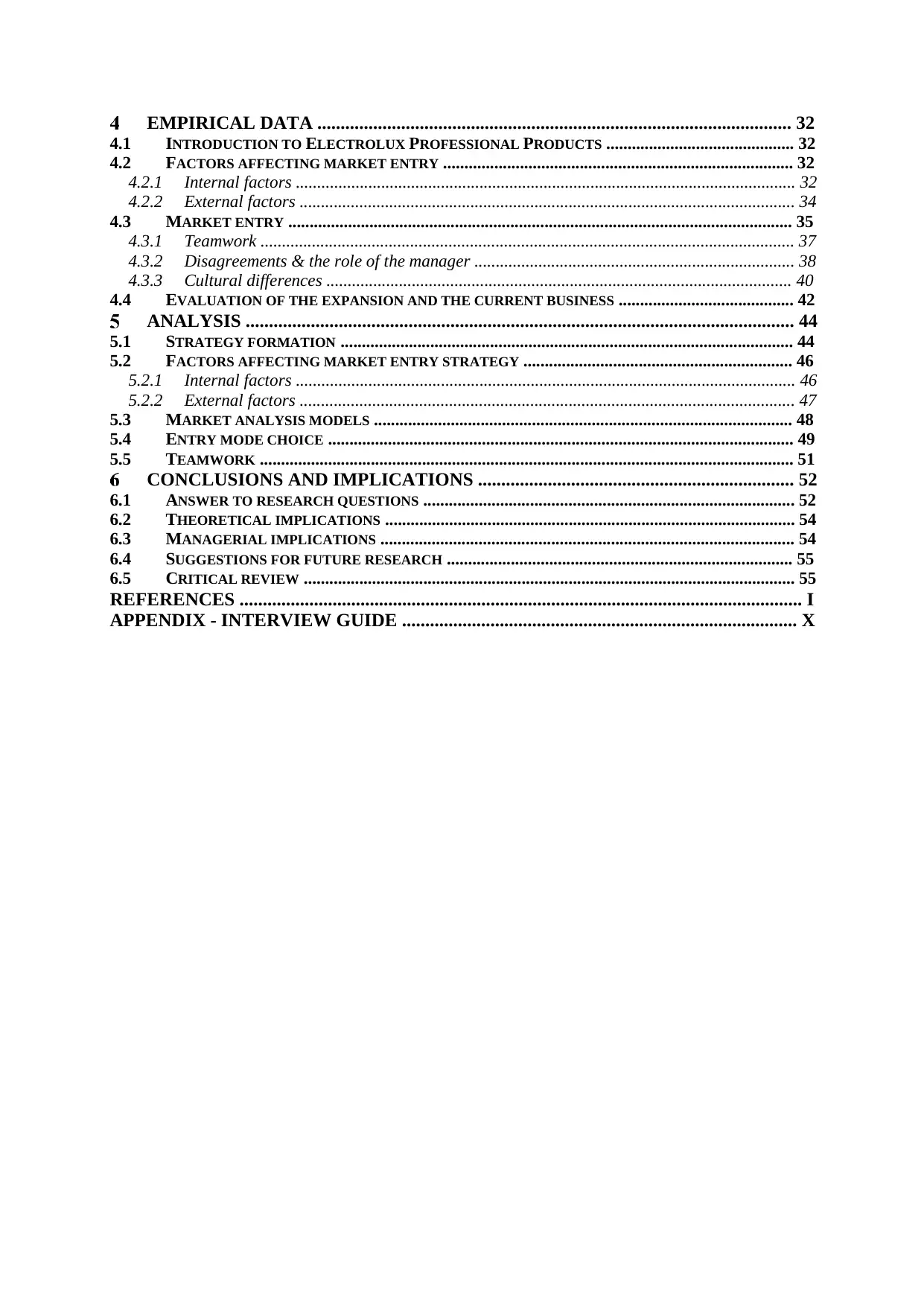
EMPIRICAL DATA ...................................................................................................... 32
4.1 INTRODUCTION TO ELECTROLUX PROFESSIONAL PRODUCTS ............................................ 32
4.2 FACTORS AFFECTING MARKET ENTRY .................................................................................. 32
4.2.1 Internal factors ..................................................................................................................... 32
4.2.2 External factors .................................................................................................................... 34
4.3 MARKET ENTRY ...................................................................................................................... 35
4.3.1 Teamwork ............................................................................................................................. 37
4.3.2 Disagreements & the role of the manager ........................................................................... 38
4.3.3 Cultural differences ............................................................................................................. 40
4.4 EVALUATION OF THE EXPANSION AND THE CURRENT BUSINESS ......................................... 42
ANALYSIS ...................................................................................................................... 44
5.1 STRATEGY FORMATION .......................................................................................................... 44
5.2 FACTORS AFFECTING MARKET ENTRY STRATEGY ............................................................... 46
5.2.1 Internal factors ..................................................................................................................... 46
5.2.2 External factors .................................................................................................................... 47
5.3 MARKET ANALYSIS MODELS .................................................................................................. 48
5.4 ENTRY MODE CHOICE ............................................................................................................. 49
5.5 TEAMWORK ............................................................................................................................. 51
CONCLUSIONS AND IMPLICATIONS .................................................................... 52
6.1 ANSWER TO RESEARCH QUESTIONS ....................................................................................... 52
6.2 THEORETICAL IMPLICATIONS ................................................................................................ 54
6.3 MANAGERIAL IMPLICATIONS ................................................................................................. 54
6.4 SUGGESTIONS FOR FUTURE RESEARCH ................................................................................. 55
6.5 CRITICAL REVIEW ................................................................................................................... 55
REFERENCES ......................................................................................................................... I
APPENDIX - INTERVIEW GUIDE ..................................................................................... X
4.1 INTRODUCTION TO ELECTROLUX PROFESSIONAL PRODUCTS ............................................ 32
4.2 FACTORS AFFECTING MARKET ENTRY .................................................................................. 32
4.2.1 Internal factors ..................................................................................................................... 32
4.2.2 External factors .................................................................................................................... 34
4.3 MARKET ENTRY ...................................................................................................................... 35
4.3.1 Teamwork ............................................................................................................................. 37
4.3.2 Disagreements & the role of the manager ........................................................................... 38
4.3.3 Cultural differences ............................................................................................................. 40
4.4 EVALUATION OF THE EXPANSION AND THE CURRENT BUSINESS ......................................... 42
ANALYSIS ...................................................................................................................... 44
5.1 STRATEGY FORMATION .......................................................................................................... 44
5.2 FACTORS AFFECTING MARKET ENTRY STRATEGY ............................................................... 46
5.2.1 Internal factors ..................................................................................................................... 46
5.2.2 External factors .................................................................................................................... 47
5.3 MARKET ANALYSIS MODELS .................................................................................................. 48
5.4 ENTRY MODE CHOICE ............................................................................................................. 49
5.5 TEAMWORK ............................................................................................................................. 51
CONCLUSIONS AND IMPLICATIONS .................................................................... 52
6.1 ANSWER TO RESEARCH QUESTIONS ....................................................................................... 52
6.2 THEORETICAL IMPLICATIONS ................................................................................................ 54
6.3 MANAGERIAL IMPLICATIONS ................................................................................................. 54
6.4 SUGGESTIONS FOR FUTURE RESEARCH ................................................................................. 55
6.5 CRITICAL REVIEW ................................................................................................................... 55
REFERENCES ......................................................................................................................... I
APPENDIX - INTERVIEW GUIDE ..................................................................................... X
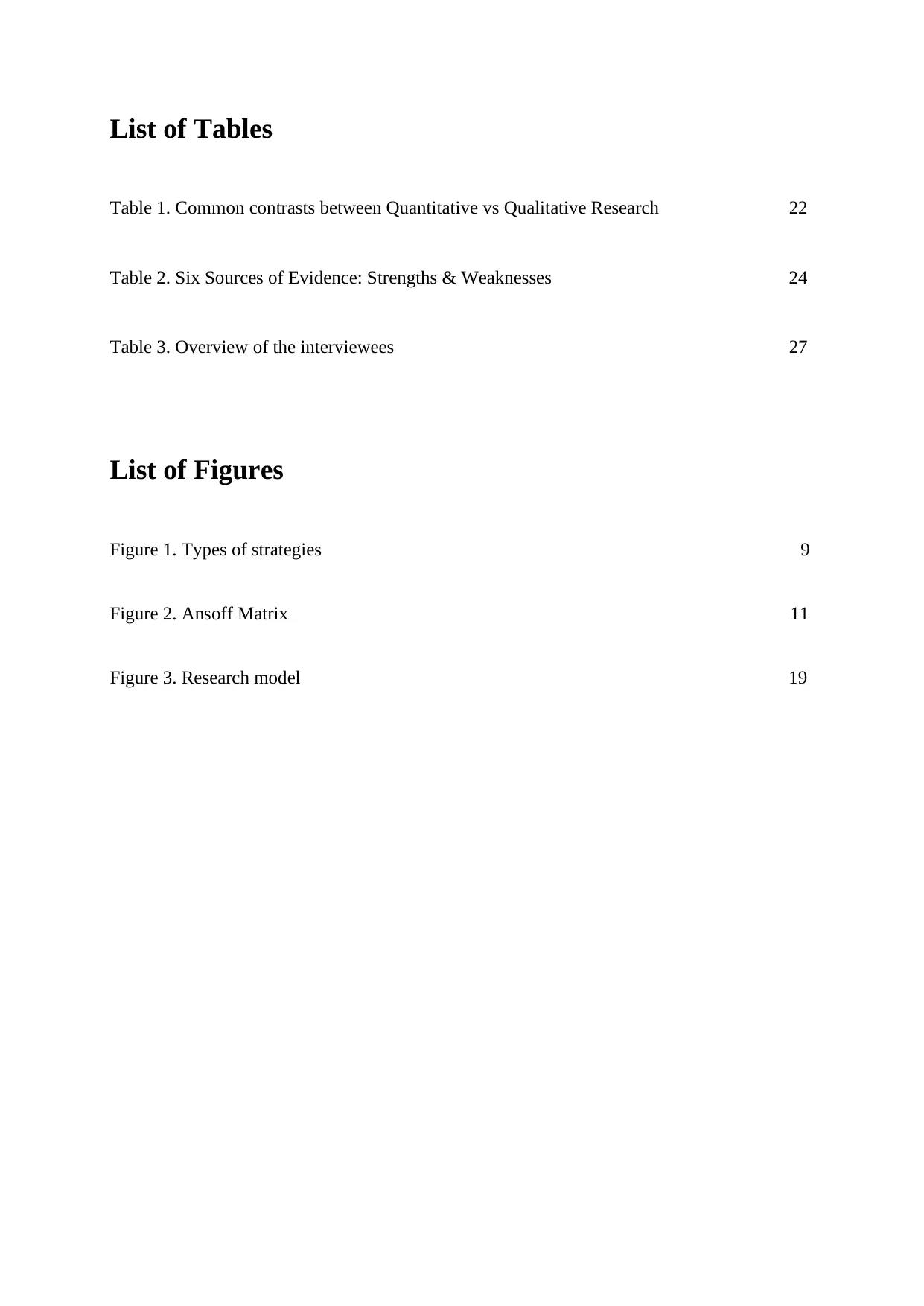
List of Tables
Table 1. Common contrasts between Quantitative vs Qualitative Research 22
Table 2. Six Sources of Evidence: Strengths & Weaknesses 24
Table 3. Overview of the interviewees 27
List of Figures
Figure 1. Types of strategies 9
Figure 2. Ansoff Matrix 11
Figure 3. Research model 19
Table 1. Common contrasts between Quantitative vs Qualitative Research 22
Table 2. Six Sources of Evidence: Strengths & Weaknesses 24
Table 3. Overview of the interviewees 27
List of Figures
Figure 1. Types of strategies 9
Figure 2. Ansoff Matrix 11
Figure 3. Research model 19
⊘ This is a preview!⊘
Do you want full access?
Subscribe today to unlock all pages.

Trusted by 1+ million students worldwide
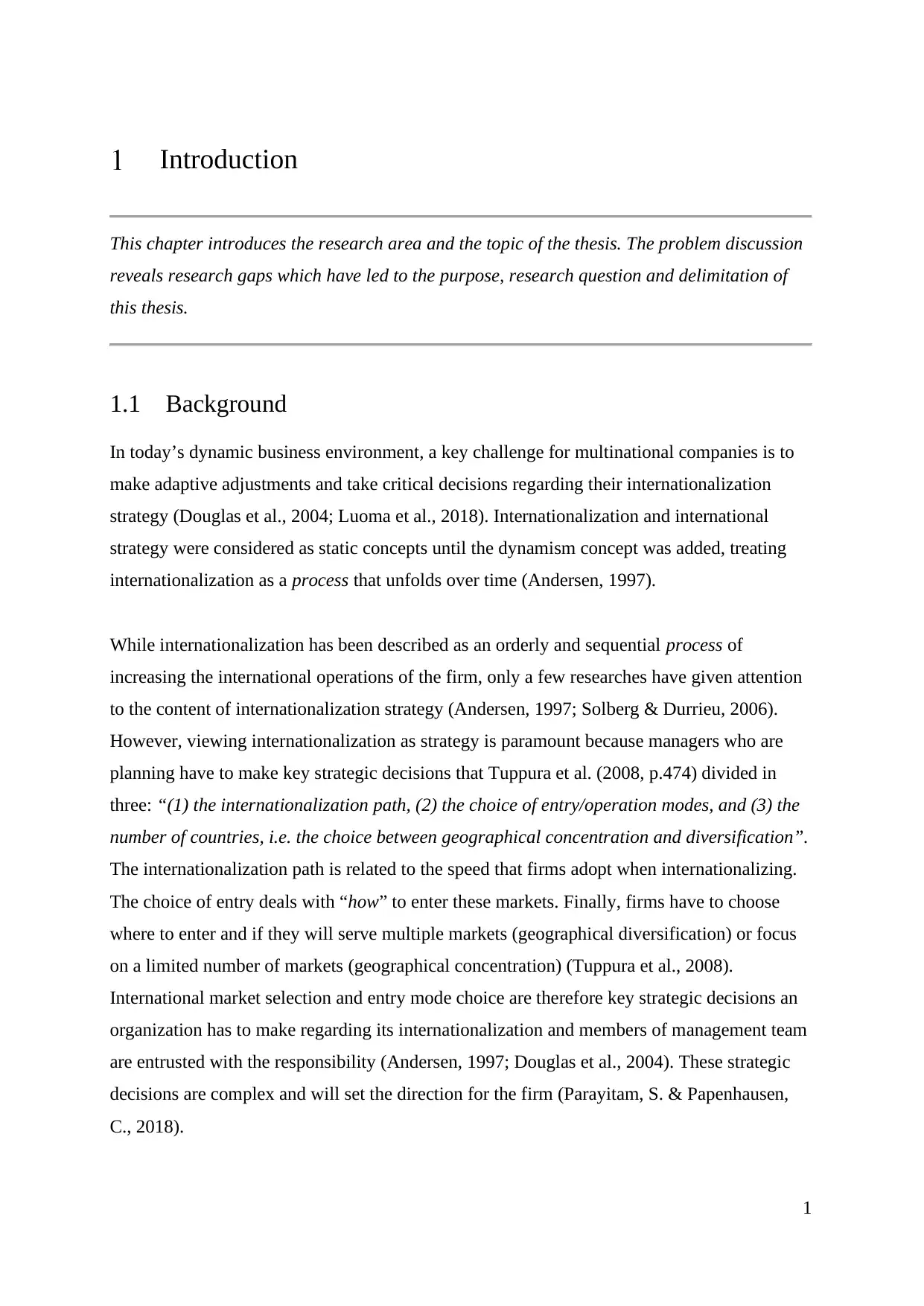
1
Introduction
This chapter introduces the research area and the topic of the thesis. The problem discussion
reveals research gaps which have led to the purpose, research question and delimitation of
this thesis.
1.1 Background
In today’s dynamic business environment, a key challenge for multinational companies is to
make adaptive adjustments and take critical decisions regarding their internationalization
strategy (Douglas et al., 2004; Luoma et al., 2018). Internationalization and international
strategy were considered as static concepts until the dynamism concept was added, treating
internationalization as a process that unfolds over time (Andersen, 1997).
While internationalization has been described as an orderly and sequential process of
increasing the international operations of the firm, only a few researches have given attention
to the content of internationalization strategy (Andersen, 1997; Solberg & Durrieu, 2006).
However, viewing internationalization as strategy is paramount because managers who are
planning have to make key strategic decisions that Tuppura et al. (2008, p.474) divided in
three: “(1) the internationalization path, (2) the choice of entry/operation modes, and (3) the
number of countries, i.e. the choice between geographical concentration and diversification”.
The internationalization path is related to the speed that firms adopt when internationalizing.
The choice of entry deals with “how” to enter these markets. Finally, firms have to choose
where to enter and if they will serve multiple markets (geographical diversification) or focus
on a limited number of markets (geographical concentration) (Tuppura et al., 2008).
International market selection and entry mode choice are therefore key strategic decisions an
organization has to make regarding its internationalization and members of management team
are entrusted with the responsibility (Andersen, 1997; Douglas et al., 2004). These strategic
decisions are complex and will set the direction for the firm (Parayitam, S. & Papenhausen,
C., 2018).
Introduction
This chapter introduces the research area and the topic of the thesis. The problem discussion
reveals research gaps which have led to the purpose, research question and delimitation of
this thesis.
1.1 Background
In today’s dynamic business environment, a key challenge for multinational companies is to
make adaptive adjustments and take critical decisions regarding their internationalization
strategy (Douglas et al., 2004; Luoma et al., 2018). Internationalization and international
strategy were considered as static concepts until the dynamism concept was added, treating
internationalization as a process that unfolds over time (Andersen, 1997).
While internationalization has been described as an orderly and sequential process of
increasing the international operations of the firm, only a few researches have given attention
to the content of internationalization strategy (Andersen, 1997; Solberg & Durrieu, 2006).
However, viewing internationalization as strategy is paramount because managers who are
planning have to make key strategic decisions that Tuppura et al. (2008, p.474) divided in
three: “(1) the internationalization path, (2) the choice of entry/operation modes, and (3) the
number of countries, i.e. the choice between geographical concentration and diversification”.
The internationalization path is related to the speed that firms adopt when internationalizing.
The choice of entry deals with “how” to enter these markets. Finally, firms have to choose
where to enter and if they will serve multiple markets (geographical diversification) or focus
on a limited number of markets (geographical concentration) (Tuppura et al., 2008).
International market selection and entry mode choice are therefore key strategic decisions an
organization has to make regarding its internationalization and members of management team
are entrusted with the responsibility (Andersen, 1997; Douglas et al., 2004). These strategic
decisions are complex and will set the direction for the firm (Parayitam, S. & Papenhausen,
C., 2018).
Paraphrase This Document
Need a fresh take? Get an instant paraphrase of this document with our AI Paraphraser
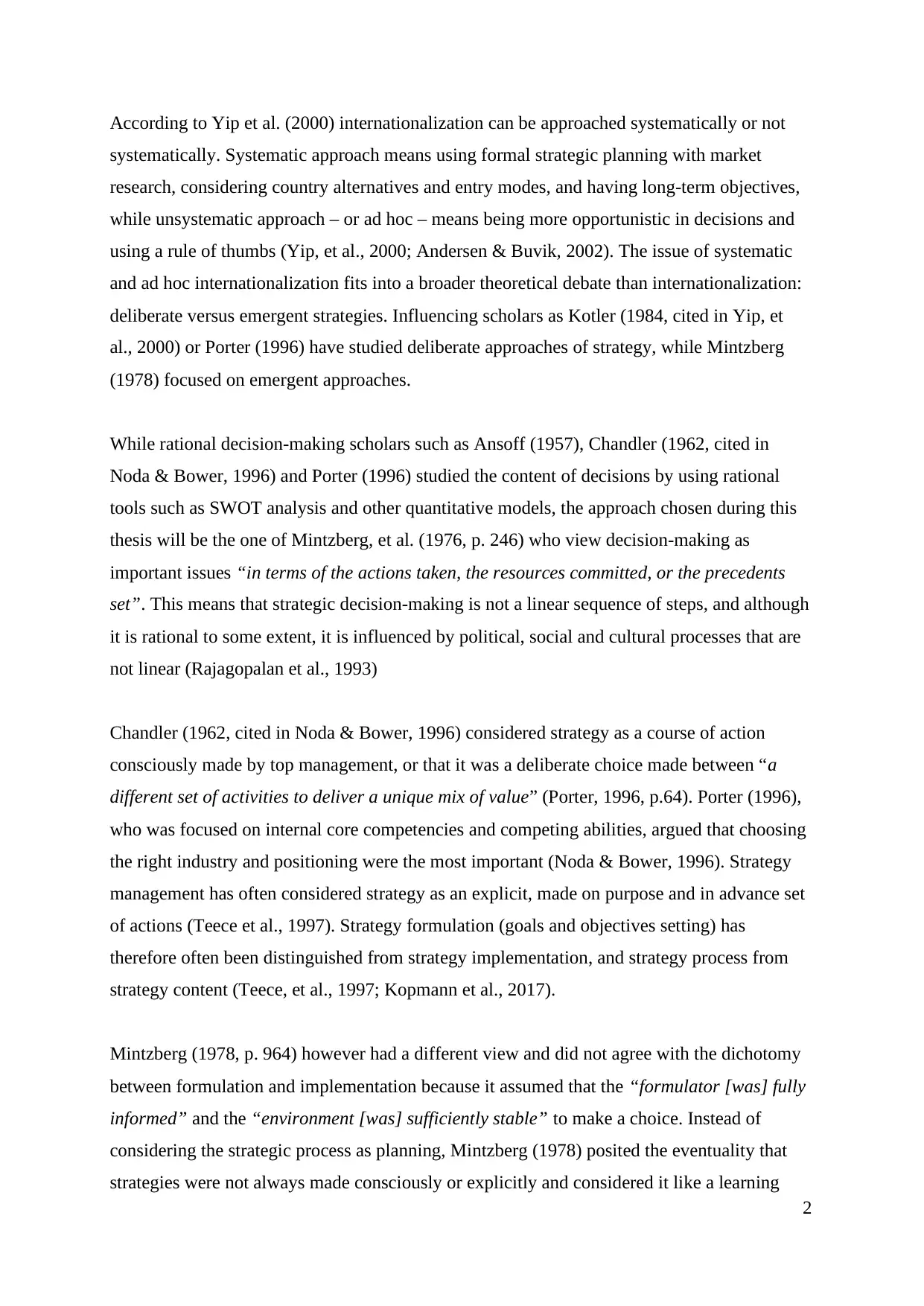
2
According to Yip et al. (2000) internationalization can be approached systematically or not
systematically. Systematic approach means using formal strategic planning with market
research, considering country alternatives and entry modes, and having long-term objectives,
while unsystematic approach – or ad hoc – means being more opportunistic in decisions and
using a rule of thumbs (Yip, et al., 2000; Andersen & Buvik, 2002). The issue of systematic
and ad hoc internationalization fits into a broader theoretical debate than internationalization:
deliberate versus emergent strategies. Influencing scholars as Kotler (1984, cited in Yip, et
al., 2000) or Porter (1996) have studied deliberate approaches of strategy, while Mintzberg
(1978) focused on emergent approaches.
While rational decision-making scholars such as Ansoff (1957), Chandler (1962, cited in
Noda & Bower, 1996) and Porter (1996) studied the content of decisions by using rational
tools such as SWOT analysis and other quantitative models, the approach chosen during this
thesis will be the one of Mintzberg, et al. (1976, p. 246) who view decision-making as
important issues “in terms of the actions taken, the resources committed, or the precedents
set”. This means that strategic decision-making is not a linear sequence of steps, and although
it is rational to some extent, it is influenced by political, social and cultural processes that are
not linear (Rajagopalan et al., 1993)
Chandler (1962, cited in Noda & Bower, 1996) considered strategy as a course of action
consciously made by top management, or that it was a deliberate choice made between “a
different set of activities to deliver a unique mix of value” (Porter, 1996, p.64). Porter (1996),
who was focused on internal core competencies and competing abilities, argued that choosing
the right industry and positioning were the most important (Noda & Bower, 1996). Strategy
management has often considered strategy as an explicit, made on purpose and in advance set
of actions (Teece et al., 1997). Strategy formulation (goals and objectives setting) has
therefore often been distinguished from strategy implementation, and strategy process from
strategy content (Teece, et al., 1997; Kopmann et al., 2017).
Mintzberg (1978, p. 964) however had a different view and did not agree with the dichotomy
between formulation and implementation because it assumed that the “formulator [was] fully
informed” and the “environment [was] sufficiently stable” to make a choice. Instead of
considering the strategic process as planning, Mintzberg (1978) posited the eventuality that
strategies were not always made consciously or explicitly and considered it like a learning
According to Yip et al. (2000) internationalization can be approached systematically or not
systematically. Systematic approach means using formal strategic planning with market
research, considering country alternatives and entry modes, and having long-term objectives,
while unsystematic approach – or ad hoc – means being more opportunistic in decisions and
using a rule of thumbs (Yip, et al., 2000; Andersen & Buvik, 2002). The issue of systematic
and ad hoc internationalization fits into a broader theoretical debate than internationalization:
deliberate versus emergent strategies. Influencing scholars as Kotler (1984, cited in Yip, et
al., 2000) or Porter (1996) have studied deliberate approaches of strategy, while Mintzberg
(1978) focused on emergent approaches.
While rational decision-making scholars such as Ansoff (1957), Chandler (1962, cited in
Noda & Bower, 1996) and Porter (1996) studied the content of decisions by using rational
tools such as SWOT analysis and other quantitative models, the approach chosen during this
thesis will be the one of Mintzberg, et al. (1976, p. 246) who view decision-making as
important issues “in terms of the actions taken, the resources committed, or the precedents
set”. This means that strategic decision-making is not a linear sequence of steps, and although
it is rational to some extent, it is influenced by political, social and cultural processes that are
not linear (Rajagopalan et al., 1993)
Chandler (1962, cited in Noda & Bower, 1996) considered strategy as a course of action
consciously made by top management, or that it was a deliberate choice made between “a
different set of activities to deliver a unique mix of value” (Porter, 1996, p.64). Porter (1996),
who was focused on internal core competencies and competing abilities, argued that choosing
the right industry and positioning were the most important (Noda & Bower, 1996). Strategy
management has often considered strategy as an explicit, made on purpose and in advance set
of actions (Teece et al., 1997). Strategy formulation (goals and objectives setting) has
therefore often been distinguished from strategy implementation, and strategy process from
strategy content (Teece, et al., 1997; Kopmann et al., 2017).
Mintzberg (1978, p. 964) however had a different view and did not agree with the dichotomy
between formulation and implementation because it assumed that the “formulator [was] fully
informed” and the “environment [was] sufficiently stable” to make a choice. Instead of
considering the strategic process as planning, Mintzberg (1978) posited the eventuality that
strategies were not always made consciously or explicitly and considered it like a learning
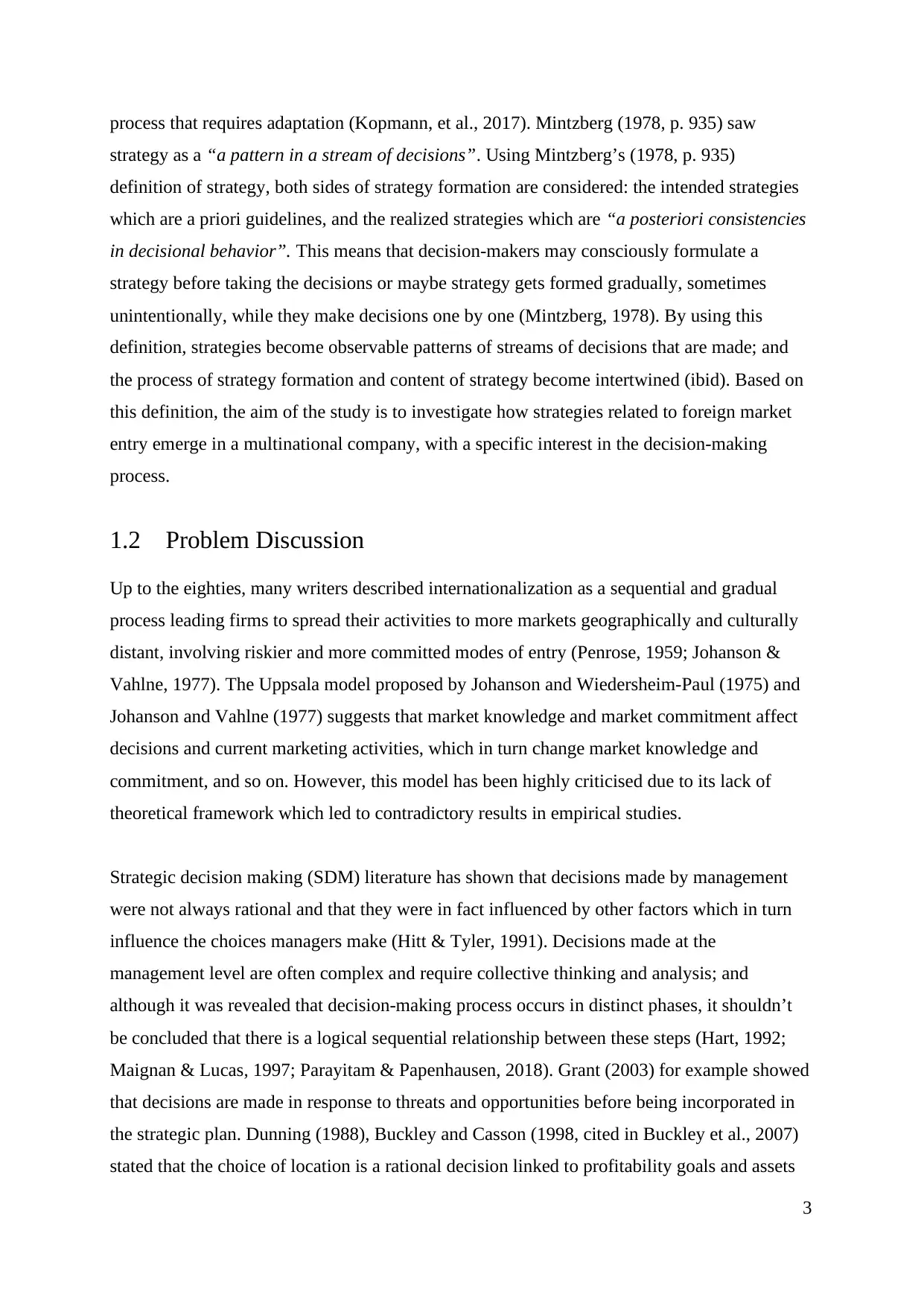
3
process that requires adaptation (Kopmann, et al., 2017). Mintzberg (1978, p. 935) saw
strategy as a “a pattern in a stream of decisions”. Using Mintzberg’s (1978, p. 935)
definition of strategy, both sides of strategy formation are considered: the intended strategies
which are a priori guidelines, and the realized strategies which are “a posteriori consistencies
in decisional behavior”. This means that decision-makers may consciously formulate a
strategy before taking the decisions or maybe strategy gets formed gradually, sometimes
unintentionally, while they make decisions one by one (Mintzberg, 1978). By using this
definition, strategies become observable patterns of streams of decisions that are made; and
the process of strategy formation and content of strategy become intertwined (ibid). Based on
this definition, the aim of the study is to investigate how strategies related to foreign market
entry emerge in a multinational company, with a specific interest in the decision-making
process.
1.2 Problem Discussion
Up to the eighties, many writers described internationalization as a sequential and gradual
process leading firms to spread their activities to more markets geographically and culturally
distant, involving riskier and more committed modes of entry (Penrose, 1959; Johanson &
Vahlne, 1977). The Uppsala model proposed by Johanson and Wiedersheim-Paul (1975) and
Johanson and Vahlne (1977) suggests that market knowledge and market commitment affect
decisions and current marketing activities, which in turn change market knowledge and
commitment, and so on. However, this model has been highly criticised due to its lack of
theoretical framework which led to contradictory results in empirical studies.
Strategic decision making (SDM) literature has shown that decisions made by management
were not always rational and that they were in fact influenced by other factors which in turn
influence the choices managers make (Hitt & Tyler, 1991). Decisions made at the
management level are often complex and require collective thinking and analysis; and
although it was revealed that decision-making process occurs in distinct phases, it shouldn’t
be concluded that there is a logical sequential relationship between these steps (Hart, 1992;
Maignan & Lucas, 1997; Parayitam & Papenhausen, 2018). Grant (2003) for example showed
that decisions are made in response to threats and opportunities before being incorporated in
the strategic plan. Dunning (1988), Buckley and Casson (1998, cited in Buckley et al., 2007)
stated that the choice of location is a rational decision linked to profitability goals and assets
process that requires adaptation (Kopmann, et al., 2017). Mintzberg (1978, p. 935) saw
strategy as a “a pattern in a stream of decisions”. Using Mintzberg’s (1978, p. 935)
definition of strategy, both sides of strategy formation are considered: the intended strategies
which are a priori guidelines, and the realized strategies which are “a posteriori consistencies
in decisional behavior”. This means that decision-makers may consciously formulate a
strategy before taking the decisions or maybe strategy gets formed gradually, sometimes
unintentionally, while they make decisions one by one (Mintzberg, 1978). By using this
definition, strategies become observable patterns of streams of decisions that are made; and
the process of strategy formation and content of strategy become intertwined (ibid). Based on
this definition, the aim of the study is to investigate how strategies related to foreign market
entry emerge in a multinational company, with a specific interest in the decision-making
process.
1.2 Problem Discussion
Up to the eighties, many writers described internationalization as a sequential and gradual
process leading firms to spread their activities to more markets geographically and culturally
distant, involving riskier and more committed modes of entry (Penrose, 1959; Johanson &
Vahlne, 1977). The Uppsala model proposed by Johanson and Wiedersheim-Paul (1975) and
Johanson and Vahlne (1977) suggests that market knowledge and market commitment affect
decisions and current marketing activities, which in turn change market knowledge and
commitment, and so on. However, this model has been highly criticised due to its lack of
theoretical framework which led to contradictory results in empirical studies.
Strategic decision making (SDM) literature has shown that decisions made by management
were not always rational and that they were in fact influenced by other factors which in turn
influence the choices managers make (Hitt & Tyler, 1991). Decisions made at the
management level are often complex and require collective thinking and analysis; and
although it was revealed that decision-making process occurs in distinct phases, it shouldn’t
be concluded that there is a logical sequential relationship between these steps (Hart, 1992;
Maignan & Lucas, 1997; Parayitam & Papenhausen, 2018). Grant (2003) for example showed
that decisions are made in response to threats and opportunities before being incorporated in
the strategic plan. Dunning (1988), Buckley and Casson (1998, cited in Buckley et al., 2007)
stated that the choice of location is a rational decision linked to profitability goals and assets
⊘ This is a preview!⊘
Do you want full access?
Subscribe today to unlock all pages.

Trusted by 1+ million students worldwide
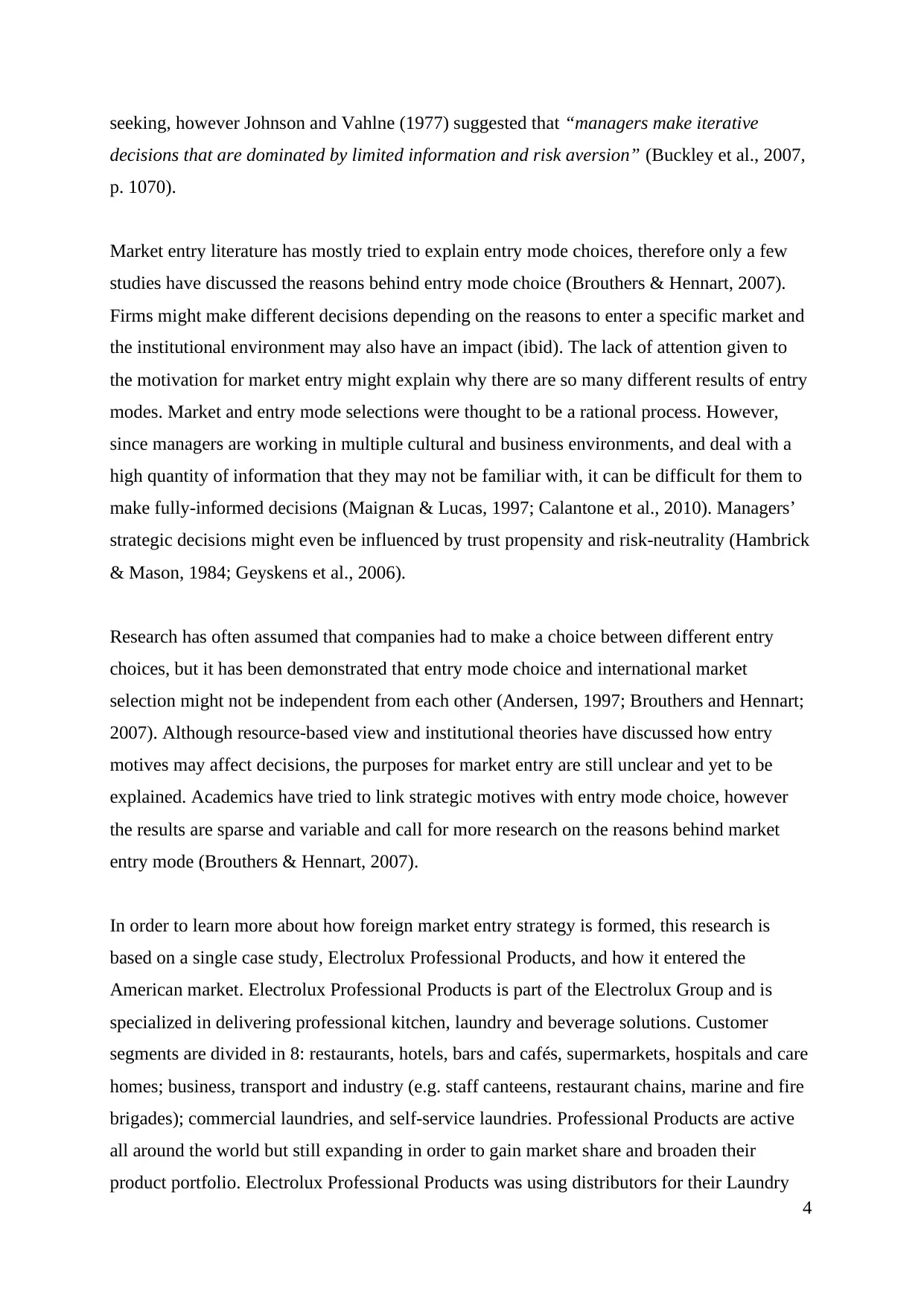
4
seeking, however Johnson and Vahlne (1977) suggested that “managers make iterative
decisions that are dominated by limited information and risk aversion” (Buckley et al., 2007,
p. 1070).
Market entry literature has mostly tried to explain entry mode choices, therefore only a few
studies have discussed the reasons behind entry mode choice (Brouthers & Hennart, 2007).
Firms might make different decisions depending on the reasons to enter a specific market and
the institutional environment may also have an impact (ibid). The lack of attention given to
the motivation for market entry might explain why there are so many different results of entry
modes. Market and entry mode selections were thought to be a rational process. However,
since managers are working in multiple cultural and business environments, and deal with a
high quantity of information that they may not be familiar with, it can be difficult for them to
make fully-informed decisions (Maignan & Lucas, 1997; Calantone et al., 2010). Managers’
strategic decisions might even be influenced by trust propensity and risk-neutrality (Hambrick
& Mason, 1984; Geyskens et al., 2006).
Research has often assumed that companies had to make a choice between different entry
choices, but it has been demonstrated that entry mode choice and international market
selection might not be independent from each other (Andersen, 1997; Brouthers and Hennart;
2007). Although resource-based view and institutional theories have discussed how entry
motives may affect decisions, the purposes for market entry are still unclear and yet to be
explained. Academics have tried to link strategic motives with entry mode choice, however
the results are sparse and variable and call for more research on the reasons behind market
entry mode (Brouthers & Hennart, 2007).
In order to learn more about how foreign market entry strategy is formed, this research is
based on a single case study, Electrolux Professional Products, and how it entered the
American market. Electrolux Professional Products is part of the Electrolux Group and is
specialized in delivering professional kitchen, laundry and beverage solutions. Customer
segments are divided in 8: restaurants, hotels, bars and cafés, supermarkets, hospitals and care
homes; business, transport and industry (e.g. staff canteens, restaurant chains, marine and fire
brigades); commercial laundries, and self-service laundries. Professional Products are active
all around the world but still expanding in order to gain market share and broaden their
product portfolio. Electrolux Professional Products was using distributors for their Laundry
seeking, however Johnson and Vahlne (1977) suggested that “managers make iterative
decisions that are dominated by limited information and risk aversion” (Buckley et al., 2007,
p. 1070).
Market entry literature has mostly tried to explain entry mode choices, therefore only a few
studies have discussed the reasons behind entry mode choice (Brouthers & Hennart, 2007).
Firms might make different decisions depending on the reasons to enter a specific market and
the institutional environment may also have an impact (ibid). The lack of attention given to
the motivation for market entry might explain why there are so many different results of entry
modes. Market and entry mode selections were thought to be a rational process. However,
since managers are working in multiple cultural and business environments, and deal with a
high quantity of information that they may not be familiar with, it can be difficult for them to
make fully-informed decisions (Maignan & Lucas, 1997; Calantone et al., 2010). Managers’
strategic decisions might even be influenced by trust propensity and risk-neutrality (Hambrick
& Mason, 1984; Geyskens et al., 2006).
Research has often assumed that companies had to make a choice between different entry
choices, but it has been demonstrated that entry mode choice and international market
selection might not be independent from each other (Andersen, 1997; Brouthers and Hennart;
2007). Although resource-based view and institutional theories have discussed how entry
motives may affect decisions, the purposes for market entry are still unclear and yet to be
explained. Academics have tried to link strategic motives with entry mode choice, however
the results are sparse and variable and call for more research on the reasons behind market
entry mode (Brouthers & Hennart, 2007).
In order to learn more about how foreign market entry strategy is formed, this research is
based on a single case study, Electrolux Professional Products, and how it entered the
American market. Electrolux Professional Products is part of the Electrolux Group and is
specialized in delivering professional kitchen, laundry and beverage solutions. Customer
segments are divided in 8: restaurants, hotels, bars and cafés, supermarkets, hospitals and care
homes; business, transport and industry (e.g. staff canteens, restaurant chains, marine and fire
brigades); commercial laundries, and self-service laundries. Professional Products are active
all around the world but still expanding in order to gain market share and broaden their
product portfolio. Electrolux Professional Products was using distributors for their Laundry
Paraphrase This Document
Need a fresh take? Get an instant paraphrase of this document with our AI Paraphraser
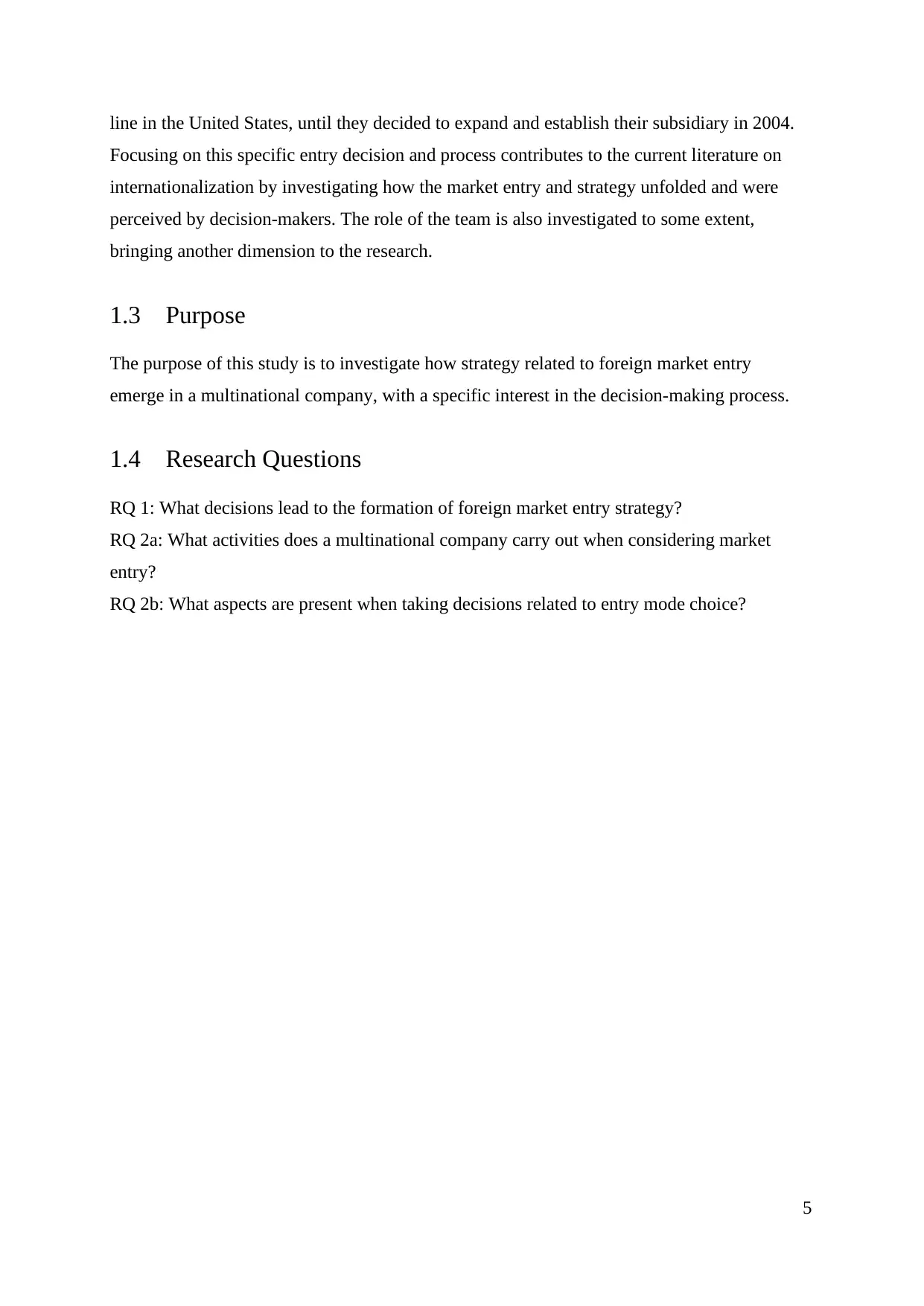
5
line in the United States, until they decided to expand and establish their subsidiary in 2004.
Focusing on this specific entry decision and process contributes to the current literature on
internationalization by investigating how the market entry and strategy unfolded and were
perceived by decision-makers. The role of the team is also investigated to some extent,
bringing another dimension to the research.
1.3 Purpose
The purpose of this study is to investigate how strategy related to foreign market entry
emerge in a multinational company, with a specific interest in the decision-making process.
1.4 Research Questions
RQ 1: What decisions lead to the formation of foreign market entry strategy?
RQ 2a: What activities does a multinational company carry out when considering market
entry?
RQ 2b: What aspects are present when taking decisions related to entry mode choice?
line in the United States, until they decided to expand and establish their subsidiary in 2004.
Focusing on this specific entry decision and process contributes to the current literature on
internationalization by investigating how the market entry and strategy unfolded and were
perceived by decision-makers. The role of the team is also investigated to some extent,
bringing another dimension to the research.
1.3 Purpose
The purpose of this study is to investigate how strategy related to foreign market entry
emerge in a multinational company, with a specific interest in the decision-making process.
1.4 Research Questions
RQ 1: What decisions lead to the formation of foreign market entry strategy?
RQ 2a: What activities does a multinational company carry out when considering market
entry?
RQ 2b: What aspects are present when taking decisions related to entry mode choice?
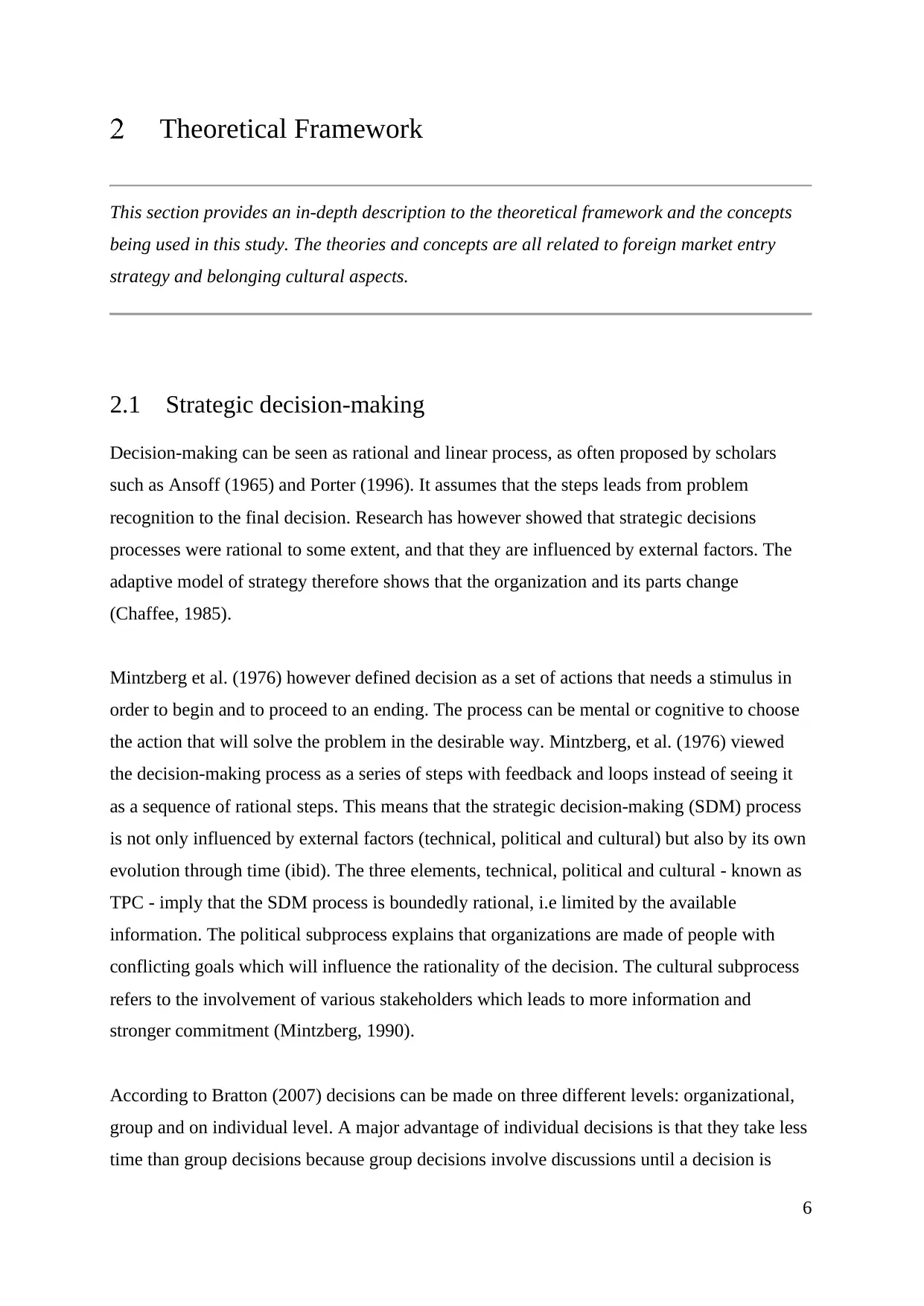
6
Theoretical Framework
This section provides an in-depth description to the theoretical framework and the concepts
being used in this study. The theories and concepts are all related to foreign market entry
strategy and belonging cultural aspects.
2.1 Strategic decision-making
Decision-making can be seen as rational and linear process, as often proposed by scholars
such as Ansoff (1965) and Porter (1996). It assumes that the steps leads from problem
recognition to the final decision. Research has however showed that strategic decisions
processes were rational to some extent, and that they are influenced by external factors. The
adaptive model of strategy therefore shows that the organization and its parts change
(Chaffee, 1985).
Mintzberg et al. (1976) however defined decision as a set of actions that needs a stimulus in
order to begin and to proceed to an ending. The process can be mental or cognitive to choose
the action that will solve the problem in the desirable way. Mintzberg, et al. (1976) viewed
the decision-making process as a series of steps with feedback and loops instead of seeing it
as a sequence of rational steps. This means that the strategic decision-making (SDM) process
is not only influenced by external factors (technical, political and cultural) but also by its own
evolution through time (ibid). The three elements, technical, political and cultural - known as
TPC - imply that the SDM process is boundedly rational, i.e limited by the available
information. The political subprocess explains that organizations are made of people with
conflicting goals which will influence the rationality of the decision. The cultural subprocess
refers to the involvement of various stakeholders which leads to more information and
stronger commitment (Mintzberg, 1990).
According to Bratton (2007) decisions can be made on three different levels: organizational,
group and on individual level. A major advantage of individual decisions is that they take less
time than group decisions because group decisions involve discussions until a decision is
Theoretical Framework
This section provides an in-depth description to the theoretical framework and the concepts
being used in this study. The theories and concepts are all related to foreign market entry
strategy and belonging cultural aspects.
2.1 Strategic decision-making
Decision-making can be seen as rational and linear process, as often proposed by scholars
such as Ansoff (1965) and Porter (1996). It assumes that the steps leads from problem
recognition to the final decision. Research has however showed that strategic decisions
processes were rational to some extent, and that they are influenced by external factors. The
adaptive model of strategy therefore shows that the organization and its parts change
(Chaffee, 1985).
Mintzberg et al. (1976) however defined decision as a set of actions that needs a stimulus in
order to begin and to proceed to an ending. The process can be mental or cognitive to choose
the action that will solve the problem in the desirable way. Mintzberg, et al. (1976) viewed
the decision-making process as a series of steps with feedback and loops instead of seeing it
as a sequence of rational steps. This means that the strategic decision-making (SDM) process
is not only influenced by external factors (technical, political and cultural) but also by its own
evolution through time (ibid). The three elements, technical, political and cultural - known as
TPC - imply that the SDM process is boundedly rational, i.e limited by the available
information. The political subprocess explains that organizations are made of people with
conflicting goals which will influence the rationality of the decision. The cultural subprocess
refers to the involvement of various stakeholders which leads to more information and
stronger commitment (Mintzberg, 1990).
According to Bratton (2007) decisions can be made on three different levels: organizational,
group and on individual level. A major advantage of individual decisions is that they take less
time than group decisions because group decisions involve discussions until a decision is
⊘ This is a preview!⊘
Do you want full access?
Subscribe today to unlock all pages.

Trusted by 1+ million students worldwide
1 out of 72
Your All-in-One AI-Powered Toolkit for Academic Success.
+13062052269
info@desklib.com
Available 24*7 on WhatsApp / Email
![[object Object]](/_next/static/media/star-bottom.7253800d.svg)
Unlock your academic potential
Copyright © 2020–2025 A2Z Services. All Rights Reserved. Developed and managed by ZUCOL.